- Home
- Unemployment
- Labor Force Participation Rate
- Why is it Declining?

Why is the Labor Force Participation Rate Declining/falling?
Questions regarding the health of labor markets in the post pandemic western world are being asked with increasing regularity at a time of growing inflation, sky high government deficits, and spiraling national debts. Official answers have focused on portraying the labor market as being strong, and the economy improving, but wiser heads know this to be false.
Official unemployment statistics and job growth statistics may appear robust, but more comprehensive measures paint a different picture, which brings us to the topic of this article: Why is the labor force participation rate declining?
For details about this particular labor market measure, and why it is a better long-term indicator of the labor market's health than any official unemployment statistic, have a look at my main article:
Labor Force Participation Rate Over Time
As can be seen in the diagram below, the trend in the participation rate in the postwar period has very much been a tale of two halves. Starting in the mid 1960s there was sustained and very significant growth that lasted right up until around the year 2000. This long sustained growth resulted primarily from demographic changes i.e. the postwar baby-boom generation came of age, women entered the workforce in growing numbers, and rapid economic growth at the time created lots of jobs that encouraged more and more participation.
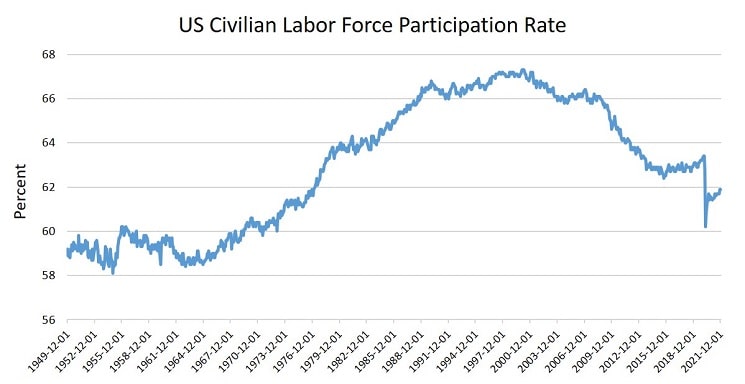 Data Source: Federal Reserve Economic Data
Data Source: Federal Reserve Economic DataThe declining labor force participation rate since the start of the new millennium has also been sustained, but the reasons for this are more complex, i.e. this is not just a reversal of the underlying causes of growth in the previous period.
In the sections below I will present an analysis of the US labor force participation rate in the postwar period, compared against that of Great Britain. A full answer to the topic of this article i.e. 'why is the labor force participation rate declining?' is not given, but some clarity over what might be at the root of it is given. I've also qualified some misunderstandings about the usual suspects in these circumstances, and shown that the assumed causes of decline are not entirely correct.
Labor Force Demographic Change
A popular explanation that has been posited by various sources holds that the reason for the declining US labor force participation rate is demographic change. The belief is that, with an aging society, the lower rates of participation that people in older age groups tend to have is reducing the overall average participation rate for the labor force as a whole.
As the graphs below illustrate, this explanation does not fully hold up to scrutiny.
The overall age composition of the labor force in both Great Britain and the US is similar, and has remained similar throughout the period. The average age of people in the two countries is similar, and the rate of aging is similar. The proportions of people in each age group is also similar and consistent over the period. All of this means that the divergence in the labor force participation rates of these two countries cannot be explained by demographic changes.
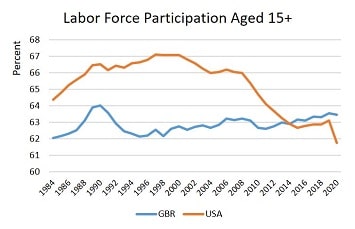
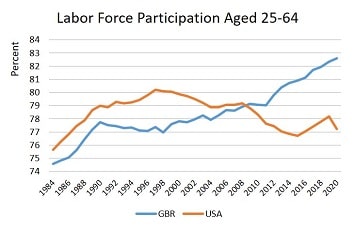
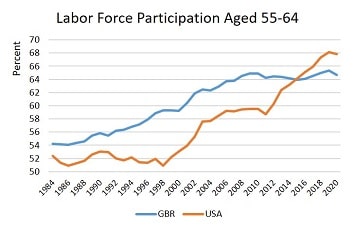
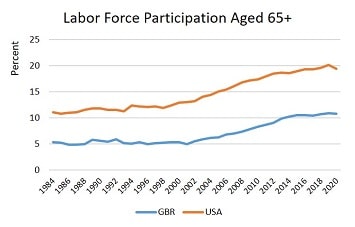
Data Source: OECD
Starting with the top left graph, the labor force participation rates for Great Britain and the US are shown for the 15 and over age group. The blue line shows that Great Britain has experienced an increase in its participation rate in recent years even while the US rate has been falling.
The question is, how have the participation rates of different age groups compared between these two countries? The other quadrants of the graph illustrate that, as we look at older and older age groups, the US performs better and better (compared to Great Britain). For people aged 65+ there is a consistent and increasingly higher participation rate in the US compared to Great Britain.
Given that this is the case, and given that the overall US participation rate has fallen slightly behind Great Britain in recent years, it follows that a significant part of the problem pertains to younger age groups, not older age groups.
It is clear, given that the US has experienced a fairly rapid increase in participation rates for people in both the older groups illustrated, that the comparative drop in participation rates has occurred most heavily for people aged from 25-55. Sadly, specific data for precise age groups is unavailable, but we can at least infer from the age groups shown that it is this younger group that has fallen behind in a comparative sense.
None of this is to state that demographic change has had no influence at all. It is clear that both countries have aging populations and that their labor force compositions now include a larger proportion of older workers. We can also see that older age groups do indeed tend to have lower participation rates than younger groups, so demographics do matter, it's just that there is more going on.
Potential Economic Causes of Labor Force Participation Rate Decline
Since demographic changes alone cannot explain what has happened, there must be other influences at play, and it appears that there is some sort of structural change taking place in the pattern of economic activity.
It could relate to differences in the impact of deindustrialization, with the UK having undergone relatively more job losses in its manufacturing industries in the 1970s and 1980s compared to the US, which has been hit relatively harder in the decades after that. The graph of trade deficits on my page about national income accounting shows some evidence to support this, but it is highly speculative to suggest that this is anywhere close to a full explanation.
It appears that another potential explanation of decline may have something to do with economic policy in the years since the 2008 financial crisis. Look again at the graph at the top of the page and you will notice that while decline began a few years earlier, the rate of decline gathered steam at the onset of the crisis in 2008. Unlike Great Britain, the US decline persisted for many years, and only started to flatten out a few years before the pandemic lockdowns hit.
Whilst research certainly needs to be done to clarify matters, there is good reason to be suspicious of the economic damage caused by vast amounts of quantitative easing, and its effects on the US economic growth rate since 2008 (which appears to have been way below trend). A slow growth rate implies reduced job creation, and this has to be a strong candidate for explaining the declining labor force participation rate.
Early Retirement Rates of Over 50s?
Continuing with the analysis of different age groups, previous research has suggested that, in the aftermath of serious recessionary periods, older workers who have been made redundant have a high tendency to leave the job market altogether and settle for early retirement.
If this is correct then the graphs above ought to have illustrated falling participation rates for older workers in the years after the 2008 financial crisis. However, the evidence is precisely the opposite for the United States, where it was older workers who actually increased their participation rates in those years.
There is no conclusive information to clarify what has happened, but it is clear that the previous thinking about early retirement for older workers is not applicable to the years after 2008. This does pose questions about what will happen to the labor force in the years after the 2020-2022 pandemic, and the deep economic recession driven by government lockdowns. The future outlook is bleak, and more decline in the labor force participation rate looks likely.
Labor Force Participation Rate vs Unemployment Rate
While economic and demographic factors have both contributed to the falling numbers of people in employment in recent decades, the official statistics on the economic health of the labor force have tended towards an unrealistic, and unhelpful, narrative that has masked the real threats posed by lower employment rates.
Our governments are understandably reluctant to raise the state retirement ages, because such a move would no doubt be deeply unpopular with the voters, but at some point the economic costs of sweeping this problem under the carpet will need to be dealt with. In this regard, the reluctance to deal with deepening labor market problems is yet another example of government failure, and yet another reason for the burgeoning size of the budget deficit.
In the United States the Federal Reserve Bank has, for many years, been accused of failing in its duty to promote economic stability. Against a backdrop of ever increasing budget deficits, most reasonable economists might have expected the Federal Reserve Bank to take action by tightening monetary policy in order to prevent excessive growth of the money supply. This did not happen, quite the reverse in fact.
So long as the official narrative focuses exclusively on the unemployment rate statistics, while disregarding the clear evidence of a falling participation rate, it is unlikely that anything will change until the coming economic collapse forces things to change.
Sources:
Related Pages:
About the Author
Steve Bain is an economics writer and analyst with a BSc in Economics and experience in regional economic development for UK local government agencies. He explains economic theory and policy through clear, accessible writing informed by both academic training and real-world work.
Read Steve’s full bio
Recent Articles
-
U.S. Industrial Policy & The Unfortunate Sacrifice that Must be Made
Dec 12, 25 03:03 AM
U.S. Industrial Policy now demands a costly tradeoff, forcing America to rebuild its industry while sacrificing bond values, pensions, and the cost of living. -
The Global Currency Reset and the End of Monetary Illusion
Dec 07, 25 03:48 AM
The global currency reset is coming. Learn why debt, inflation, and history’s warnings point to a looming transformation of the world’s financial system. -
Energy Economics and the Slow Unraveling of the Modern West
Dec 06, 25 05:18 AM
Energy economics is reshaping global power as the West faces decline. Explore how energy, geopolitics, and resource realities drive the unfolding crisis. -
Our Awful Managed Economy; is Capitalism Dead in the U.S.?
Dec 05, 25 07:07 AM
An Austrian analysis of America’s managed economy, EB Tucker’s warning, and how decades of intervention have left fragile bubbles poised for a severe reckoning. -
The Looming Global Debt Crisis – According to Matthew Piepenburg
Dec 04, 25 02:38 PM
A deep analysis of the unfolding global debt crisis, rising systemic risks, and the coming reckoning for bonds, stocks, real estate, and the dollar.